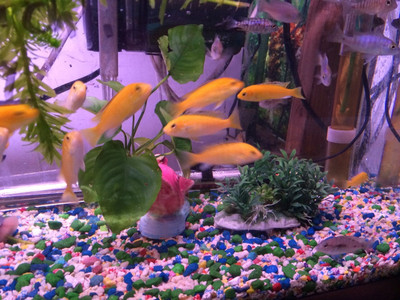Electric Yellow African Cichlid
Posted by Max Gandara on on 2nd Jan 2024
The Electric Yellow African Cichlid, scientifically known as
Labidochromis caeruleus, belongs to the Cichlidae family. With a genome
typical of cichlids, they are native to the rocky shores of Lake Malawi
in East Africa. These vibrant fish are known for their striking yellow
coloration and distinctive black dorsal fins. As a popular choice for
aquariums, Electric Yellow Cichlids exhibit social behavior and can be
territorial, especially during breeding.
Summary of Aquatic Life:
Electric Yellow African Cichlids are small to medium-sized fish with an
elongated body and characteristic coloration. Males typically display
more intense yellow hues, especially during mating displays. In their
natural habitat, they inhabit rocky areas, and replicating this
environment in captivity with ample hiding spots and caves is crucial.
These cichlids are omnivores, requiring a balanced diet of quality
pellets, supplemented with live or frozen foods like brine shrimp and
daphnia.
Creating a Happy and Healthy Environment:
1. Tank Size: A minimum tank size of 30 gallons for a small group to provide ample swimming space.
2. Water Parameters: Maintain a temperature between 75-81°F (24-27°C) and a pH level between 7.8-8.6.
3. Filtration: Efficient filtration to ensure clean and well-oxygenated water.
4. Substrate and Decor: Use fine gravel or sand substrate with rocky structures and caves for hiding places.
5. Feeding: Offer a varied diet including high-quality cichlid
pellets, live or frozen foods like brine shrimp, and occasional
vegetable matter.
Compatible Aquatic Life:
Fish:
1. Acei Cichlid (Pseudotropheus acei): Similar size and water requirements, coexisting well with Electric Yellows.
2. Red Zebra Cichlid (Maylandia estherae): Another Lake Malawi cichlid, compatible with Electric Yellows in a large tank.
3. Julidochromis Transcriptus: Smaller cichlid suitable for a community setup with Electric Yellows.
4. Frontosa Cichlid (Cyphotilapia frontosa): Larger cichlid for larger setups, cohabiting with Electric Yellows.
5. Tropheus Duboisi Cichlid: Bottom-dwelling cichlid that complements Electric Yellows in a mixed tank.
Crustaceans:
1. Red Cherry Shrimp (Neocaridina davidi): Hardy shrimp suitable for larger setups with Electric Yellows.
2. Amano Shrimp (Caridina multidentata): Non-aggressive shrimp compatible with cichlids.
3. Ghost Shrimp (Palaemonetes spp.): Inexpensive and harmless tank cleaners.
4. Bamboo Shrimp (Atyopsis moluccensis): Larger filter-feeding shrimp suitable for larger tanks.
5. Vampire Shrimp (Atya gabonensis): Peaceful filter-feeding shrimp.
Bugs:
1. Bloodworms: High-protein live or frozen food.
2. Brine Shrimp: Excellent for conditioning and variety in diet.
3. Daphnia: Nutrient-rich live food for Electric Yellow Cichlids.
4. Tubifex Worms: Live or frozen food, providing a protein-rich option.
5. Mosquito Larvae: Natural and occasional live food.
Plants:
1. Anubias (Anubias spp.): Hardy, low-light plants for a natural aesthetic.
2. Java Fern (Microsorum pteropus): Attachable to rocks, providing cover for Electric Yellow Cichlids.
3. Vallisneria (Vallisneria spp.): Tall, grass-like plants for the background.
4. Cryptocoryne (Cryptocoryne spp.): Rooted plants adding to the overall habitat.
5. Duckweed (Lemna minor): Floating cover for a more secure environment.
Amphibians:
1. Dwarf African Clawed Frog (Hymenochirus spp.): Peaceful aquatic frogs.
2. African Dwarf Frog (Hymenochirus curtipes): Small, aquatic frogs compatible with Electric Yellow Cichlids.
3. Fire-Bellied Newt (Cynops spp.): Semi-aquatic newts suitable for a shared habitat.
4. Oriental Fire-Bellied Toad (Bombina orientalis): Colorful toads for a unique aquatic setup.
5. Mudskipper: Brackish water amphibian, providing a dynamic ecosystem.
These considerations contribute to a diverse and balanced aquatic
community, ensuring the well-being of Electric Yellow African Cichlids
and their tankmates.

